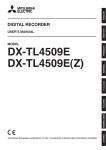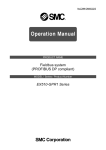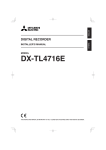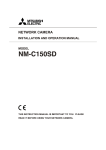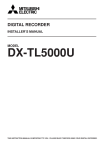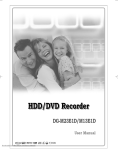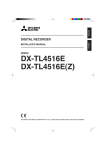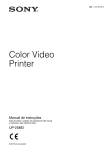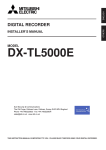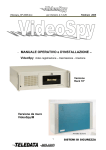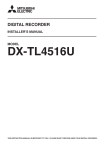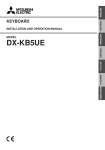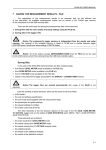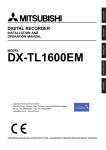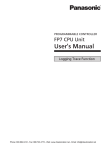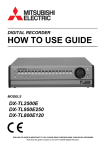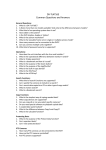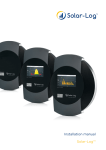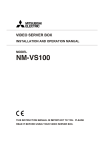Download DX-TL5000E
Transcript
ENGLISH DEUTSCH DIGITAL RECORDER USER’S MANUAL FRANÇAIS MODEL NEDERLANDS ITALIANO ESPAÑOL DX-TL5000E THIS INSTRUCTION MANUAL IS IMPORTANT TO YOU. PLEASE READ IT BEFORE USING YOUR DIGITAL RECORDER. 1 Caution and care HEAVY OBJECTS SHOULD NEVER BE PLACED ON THE UNIT (E.G., MONITOR) NEVER TOUCH OR INSERT ANY OBJECT INSIDE THE UNIT Touching the inside of the cabinet or inserting foreign objects of any kind through the disc loading slot or ventilation holes not only creates a safety hazard but can also cause extensive damage. PROTECT THE POWER CORD Damage to the power cord may cause fire or shock hazard. If the mains cord is damaged, turn OFF the MAIN switch and carefully unplug the cord by holding the mains plug. If this unit is moved with the power on status, the built-in HDD may be damaged. Confirm that more than one minute have passed since the power cord and the connecting cords were disconnected, then move this unit. Make sure to take the disc out and close the disc loading slot. UNPLUG THE POWER CORD DURING A LONG ABSENCE Turn off the power and unplug the power cord during a long absence. MAINTAIN GOOD VENTILATION Do not obstruct the many ventilation holes on the unit. For maximum ventilation, leave some space around the unit and place the unit on a hard level surface only, and ensure it is not covered during use. Heavy objects should never be placed on the unit. WHEN NOT IN USE When not in use, always eject the disc and turn OFF the MAIN switch. CABINET CARE Never use petroleum-based cleaners. Clean with a soft cloth moistened with soap and water and wipe dry. PVC cables or leads should not be left in contact with the cabinet surface for long periods. INSTALLATION LOCATION For excellent performance and lasting reliability install in a location that is:1. Well ventilated, out of direct sunlight and away from direct heat. 2. A solid vibration-free surface. 3. Free from high humidity, excessive dust and away from magnetic fields. 4. Please ensure that the ventilation fan located on the unit’s back panel is not blocked. UNSUITABLE LOCATIONS Placing the unit in the following places might shorten the product life: • Extremely cold places, such as refrigerated warehouses and ice houses • Places where excessive hydrogen sulfide is likely to be generated, such as hot-springs areas • Places or locations with salt air environment. NO OBJECTS FILLED WITH LIQUIDS, SUCH AS VASES, SHALL BE PLACED ON THE APPARATUS. DO NOT PLACE HEAVY OBJECT ON THIS UNIT. DO NOT STEP ONTO THIS UNIT. DO NOT PLACE ANY OBJECTS IN FRONT OF THE DISC LOADING SLOT. The unit may drop or fall by losing its balance. It may cause injury or failure of the unit. WARNING: TO PREVENT FIRE OR SHOCK HAZARD, DO NOT EXPOSE THIS APPARATUS TO RAIN OR MOISTURE. THIS APPARATUS MUST BE GROUNDED. •••••••••••••••••••••••••••••••••••••••••••••••••••••••••••••••••••••••••••••••••••••••••••••••••••••••••••••••••••••••••••••••••••••••••••••••••••••••••• 2 ENGLISH MAINS LEAD CONNECTION The mains lead on this unit is fitted with a non-rewireable mains plug, incorporating a 5A fuse. If you need to replace the fuse, use a 5A fuse approved by BSI or ASTA to BS 1362, ensuring you refit the fuse cover. If the mains plug is not suitable for the sockets in your home, and you require to remove the plug, remove the fuse, cut off the plug then dispose of the plug immediately, to avoid a possible electric shock hazard. To refit a new plug, follow these instructions; Green-and-yellow: Earth, Blue: Neutral and Brown: Live. As the colours in the mains lead of this unit may not correspond with the coloured markings identifying the terminals in your plug, proceed as follows. • The wire which is coloured green-and-yellow must be connected to the terminal in the plug which is marked by the letter E or by the safety earth symbol or coloured green or green-and-yellow. • The wire which is coloured blue must be connected to the terminal which is marked with the letter N or coloured black. • The wire which is coloured brown must be connected to the terminal which is marked with the letter L or coloured red. This unit complies with the requirements of the EC Directive 89/336/EEC, “EMC Directive” and 73/23/EEC, “Low Voltage Directive”, as amended by Directive 93/68/EEC. The requirements for the susceptibility according to EN 55024 and the requirements for interference according to EN 55022 are observed for the operation on residential areas, business, light industrial premises and in small scale enterprises, inside as well as outside of the building. All places of operation are characterised by their connection to the public low voltage power supply system. This unit is manufactured in accordance with EN 60950. Notice about construction of the surveillance system using this unit • This unit can be controlled by the external devices via RS-232C terminal or LAN terminal. This unit can also be used to control the external devices via external terminal, RS-422/485, or RS-232C terminal. Owning to these functions, this unit flexibly applies to the high grade security system, but the whole surveillance system may be affected by the malfunction of this unit or the external devices depending on the setting contents of this unit or the connection or combination between the external devices. • When configuring a surveillance system using this unit, it is recommended to confirm first that this unit operates normally with the other devices connected or combined. • It is recommended to copy or back up the important recorded contents to the other devices periodically. • Damages arising out of any operational error of the surveillance system or loss of the recorded data or any other damages because of any malfunction of this unit are not covered. There may be cases when the unit’s built-in MOTION DETECTION function does not operate properly due to external condition or video input signal or other factors. The user will not be indemnified for problems (e.g., recording failure or playback failure) that occur with either the unit or a connected device during operation. It is recommended that backups of important recordings are made regularly as a precaution against possible breakdowns and accidents. Recordable time and product warranty Continuous recordable time and the estimated time displayed on the menu screen is the continuous recordable time when operating this unit and is not the product warranty period. Furthermore, it is not the period that guarantees life time at the unit. • This unit uses a built-in hard disk, which is a precision device. Please handle this unit with sufficient care. • Do not subject this unit to vibrations or shocks. This may cause trouble specially when the power of the unit is turned on or when the hard disk is being accessed, and sufficient care is required. • Do not disconnect the power plug while the power of the unit is turned on or while recording or playing. • For early detection of faults, we recommend that you request inspection once a year. The hard disk and cooling fan are not permanent items and will need replacement with time. When operated in an ambient temperature of 25 °C, it is recommended that both of the hard disk and fan are replaced every 30,000 hours. (This figure is only a guide, and should not be taken as a guaranteed lifespan of the products. Use the <Elapsed Operating Time> (System Menu Service Info) as a guide to perform checkups.) ••••••••••••••••••••••••••••••••••••••••••••••••••••••••••••••••••••••••••••••••••••••••••••••••••••••••••••••••••••••••••••••••••••••••••••• Beginning 3 Caution and care (continued) INSTALLATION LOCATION AND HANDLING • Place this unit on the horizontal and stable place. If this unit is used on the unstable place, the unit may be damaged such as removal of the DVD/CD disc. • Do not place this unit close to other equipment. The equipment and this unit have a bad influence each other and the pictures or audio of this unit may be distorted. • When a monitor and this unit are placed vertically, the pictures may be distorted or DVD/CD disc may not be ejected. • Do not let stick your hands into the disc loading slot. You may get your hand caught in the slot and may got injured. If you get your hand caught, do not get out of the slot by force. Contact your dealer after turning off the power and disconnecting the plug. DVD/CD DISC • Do not use the disc cracked, deformed or repaired with adhesive. The disc may fly into pieces and cause injury. • Do not touch the playback surface when holding the disc. • When dew condensation occurs on the disk, wipe the surface off before use. • Dirt such as fingerprints or dust causes the deterioration of the picture quality and audio quality. Gently wipe the DVD/CD disc from the centre to the outside with a soft cloth. • When the disc is very dirty, soak a soft cloth with water and screw water of it, wipe off the dirt lightly, then wipe with a dry cloth. • Do not use solvent such as benzine and thinner, a record cleaner, and static-stopper. They may damage the disc. • Do not use the disc described below. They may damage the disk itself or this unit. Discs on which a piece of paper or sticker is put, or a disk damaged. Discs which the label is peeled or a disk with oozing Discs cracked, deformed, or repaired with adhesive • Store the disc in the specified casing, avoiding the following places. Places where it will be subjected to direct sunlight. Places with excessive dust. Places where it will be subjected to high temperatures or high humidity. • The movie software on the market or privately recorded picture cannot be played back on this unit. Only the picture recorded on this unit can be played back. MAINTENANCE OF THE LENS FOR RECORDING/PLAYBACK (LASER PICKUP) • When any dust adheres on the lens for recording/playback, the image may be distorted or the audio may skip. The normal recording or playback may become impossible. Ask your dealer for cleaning. The commercial lens cleaning disk may damage the lens. Do not use it. •••••••••••••••••••••••••••••••••••••••••••••••••••••••••••••••••••••••••••••••••••••••••••••••••••••••••••••••••••••••••••••••••••••••••••••••••••••••••• 4 Contents ENGLISH Caution and care ............................................................ 2-4 Contents ............................................................................. 5 How to set the menus .................................................... 6-9 Setting the menus ................................................. 6-8 How to set a menu with a mouse ....................... 6 How to set a menu with buttons on the unit ....... 6 Displaying a menu screen .................................. 7 Closing a menu screen ...................................... 7 Selecting an item ................................................ 7 Inputting numbers .............................................. 8 Setting parameters ............................................. 8 Symbols in the menus ............................................. 9 Setting the time and date ............................................... 10 Time/Date Setting (Setup Menu System Time/Date Setting) .................................................................. 10 Using the basic multiplexer functions ........................... 11 Basic multiplexer functions ..................................... 11 Multiplexer buttons ............................................ 11 Using the cascade function ........................................... 12 Cascade ................................................................. 12 Controlling the camera ................................................... 13 PTZ control ............................................................ 13 Recording the picture manually .................................... 14 Basic manual recording ......................................... 14 Setting the recording rate and picture grade for normal recording .............................................. 14 Playing back the recorded data ..................................... 15 Basic playback ....................................................... 15 Searching the desired picture ................................... 16,17 Basic search ..................................................... 16,17 Search by Time and Date ................................ 16 Search by Alarm List ........................................ 17 Copying the recorded data ........................................ 18,19 Copy (User Menu Copy) ................................. 18,19 Copy Data to Copy A Drive/Set Copy A Drive .. 18 Copy Data to Copy B Drive/Set Copy B Drive ................................................................... 18, 19 Playback software .................................................. 19 Copying the data of this unit to a video cassette ... 19 Communications by Web Browser ........................... 20-27 Communications by Web Browser ......................... 20 The personal computer product requirements . 20 Connections ..................................................... 20 Login ................................................................. 20,21 Main Menu ........................................................ 21-27 Live Monitoring ................................................. 22 Playback ........................................................... 23 Configuration Menu ..................................... 24-26 User Registration ................................... 24,25 Memo & Camera Titles ................................ 25 E-mail Setup ........................................... 25,26 NAS Setup .................................................. 26 Clock Setup ................................................. 26 Logout .............................................................. 27 Change Login User .......................................... 27 How to read this manual • Viewing displays (Refer to this information when operating): Reference information concerning operation (Caution required): Cautionary items concerning operation Troubleshooting ......................................................... 28,29 • Finding desired information There is a “Contents” at the beginning of this manual. Warnings and CALL OUT output .............................. 30,31 Warnings and their appropriate countermeasures .......................................................................... 30,31 • Troubleshooting Read Troubleshooting (pages 28, 29) for possible remedies to the problem. Microsoft is either registered trademarks or trademarks of Microsoft Corporation in the United States and/or other countries. ••••••••••••••••••••••••••••••••••••••••••••••••••••••••••••••••••••••••••••••••••••••••••••••••••••••••••••••••••••••••••••••••••••••••••••• Beginning 5 How to set the menus Setting the menus The operational conditions of this unit can be set in the menu screens. You can select and set the operational conditions by using the buttons on the front panel or the mouse connected to this unit. In the menu screen, the numbers 1 to 16 (camera number buttons) and alphabets A to E (SPLIT screen buttons) show the button names on the front panel. • When OUTPUT B is selected, the cursor of the mouse is displayed, however, the menu screen is not displayed and cannot be set. The menus can be set only when the OUTPUT A is selected. How to set a menu with a mouse • Setting a mouse step1. Attach the supplied ferrite core to the cable of the mouse as illustrated to the left. step1. Use the left and right buttons to set the menu. • Setting a menu with a mouse Wheel Left button • • Right button • Click the left button to open the menu or select a desired item, etc. Click the right button to select the active area for motion detection. With this unit, the wheel on a mouse is not available. Mouse How to set a menu with buttons on the unit step1. Use the SET UP button, camera number buttons, and the SPLIT screen buttons (A to E) to set the menu. • • M-DET DOT ON/OFF Press the SET UP button to open the menu screen. Press the camera number buttons (1 to 16) and the SPLIT screen buttons (A to E) to open each menu or select the desired item. M-DET AREA SET UP •••••••••••••••••••••••••••••••••••••••••••••••••••••••••••••••••••••••••••••••••••••••••••••••••••••••••••••••••••••••••••••••••••••••••••••••••••••••••• 6 step1. ENGLISH Displaying a menu screen Press the SET UP button or click the left button on the mouse to display a menu. • • The <User Menu> appears. To open other menu, press the D button or leftclick on “Next .” • When you use a mouse, click the following area to operate. E Exit Click this area 100 000 000 User Menu 1 Search 2 Copy 4 Audio 5 Protect Data 3 Information D Next E Exit Closing a menu screen step1. Press the E button or left-click on the “Exit” to close the menu. • You cannot close the menu by pressing the SET UP button on the unit. Setup Menu 200 000 000 1 Recording 2 Timer 4 System 5 Menu Data 3 Motion Det D Next E Exit Selecting an item step1. Press the button of the desired item or left-click on the desired item. • • The desired item menu opens. Select an item and press the number or click on the menu to open the item. M-DET DOT ON/OFF M DET E Exit 8 Reset to Factory Setting 7 Audio Setting 6 On Screen Display Setting 5 Multiplexer Setting 4 Password Setting Rear Terminal Setting 3 Setup Menu Menu Language Selection 2 1 Recording Timer 2 Time/Date Setting 1 4 System 5 Menu Data 200 000 3 Motion Det D E Next Exit •••••••••••••••••••••••••••••••••••••••••••••••••••••••••••••••••••••••••••••••••••••••••••••••••••••••••••••••••••••••••••••• How to set the menus 7 How to set the menus (continued) Inputting numbers Number input area Time Date Setting 241 000 000 ? Time Date Setting 0 1 - 0 1 - 2 0 0 4 Day Light Saving Setting step2. 0 0 : 0 0 : 0 0 14 16 A Auto When you use the buttons on the unit, step1. The number displayed in red can be input. Press the camera number buttons (0 to 9) you desire to input. To move to the next input area, press the 16 button. To go back to the previous area, press the 14 button. D When you use a mouse, step1. Left-click on the number in red until the desired number appears. Set > To move the area, left-click on the input area you desire to set or left-click or . Return E Setting parameters Time Date Setting Day Light Saving Setting Press the A button or left-click on the parameter box until the item to be set appears. step2. For some item, more detailed setting is required. In this case, an item such as “D(Set >)” is displayed. If necessary, press the D button or left-click on the “Set >” to set more details. 241 000 000 ? Time Date Setting 0 1 - 0 1 - 2 0 0 4 step1. • When you close the menu, press the E button or left click on “Return” or “Exit.” • You cannot close the menu by pressing the SET UP button on the unit. 0 0 : 0 0 : 0 0 14 16 A Auto D E Set > Return Setting or selecting area •••••••••••••••••••••••••••••••••••••••••••••••••••••••••••••••••••••••••••••••••••••••••••••••••••••••••••••••••••••••••••••••••••••••••••••••••••••••••• 8 ENGLISH Symbols in the menus Up button Motion Search (Main - Normal) Camera Select 116 000 000 A 11 CH 1 Search Start Position 15 Oldest 13 0 1 - 0 1 - 2 0 0 4 0 0 : 0 0 : 0 0 14 16 ? Menu address Help button Down button Left button Right button Setup date search starts from. Motion Detection Settings B Next > Same as Recording Setting C Motion A D Search E 12 same Return Some symbols appear in the menu screens. The meanings are follows. ? (Help) When you press the HELP button or click this symbol, the detailed information on the menu appears. (Left) When you press the 14 button or click this symbol, the item to be set shifts to left. (Right) When you press the 16 button or click this symbol, the item to be set shifts to right. (Up) When you press the 11 button or click this symbol, the value of selected item increases. (Down) When you press the 15 button or click this symbol, the value of selected item decreases. Menu address The menu address is put on each menu. You can open the menu by inputting the menu address with the buttons on the unit. For example, when opening the <Motion Search> menu, press the SET UP button and then press the camera number button in the order of 1, 6. •••••••••••••••••••••••••••••••••••••••••••••••••••••••••••••••••••••••••••••••••••••••••••••••••••••••••••••••••••••••••••••• How to set the menus 9 Setting the time and date Time/Date Setting (Setup Menu Date Setting) System Time/ This item is used to set the present date, time, and auto daylight saving setting. Auto daylight saving function is used to automatically gain the clock of the unit an hour for the specified time period. In <Day Light Saving Setting>, start/end time of the auto daylight saving function can be checked and changed. • Before you start recording, accurately set the present date and time. • The recording and playback are not performed correctly when the clock of this unit does not run. Check that the clock of this unit running before operation. Setup Menu 4 System steps 1, 2 1 Time/Date Setting step D 3 Day Light Saving Setting step1. Set the present date, month, year, hour, minute, and second. step2. Select the desired setting for daylight saving. Auto: Automatically gains the clock of the unit for the time period set in the <Day Light Saving Setting>. Off: Does not activate the auto daylight saving function. step3. When setting “Auto” for “Day Light Saving Setting,” set the day of the week, month, hour and minute of start/end time for the auto daylight saving function. • The time is indicated using the 24-hour system. • This unit uses 4 digits to display the year. The available display range is 37 years between 1/1/2001 to 31/12/2037. The unit is also equipped with a function to automatically calculate leap years. The year returns to 2001 after 31/12/2037. •••••••••••••••••••••••••••••••••••••••••••••••••••••••••••••••••••••••••••••••••••••••••••••••••••••••••••••••••••••••••••••••••••••••••••••••••••••••••• 10 Using the basic multiplexer functions This function is used to perform the multiplexer functions using the buttons on the front panel. DIGITAL ZOOM button Camera number buttons M-DET DOT ON/OFF M-DET AREA SET UP SPEED SPLIT screen buttons ENGLISH Basic multiplexer functions • The sequential display is cancelled when the different type of the split screen is displayed. • Pressing the OUTPUT A/B button on the front panel switches the multiplexer output of the unit. When OUTPUT A is selected, the light of the button turns off. When OUTPUT B is selected, the button lights up and camera number buttons, SPLIT screen buttons, and SEQUENCE button are operated for the monitor screen connected to the OUTPUT B connector. Pressing the OUTPUT A/B button again switches the multiplexer output to OUTPUT A. 4. DIGITAL ZOOM button Displays magnification 100% screen when pressing this button during single screen display. At this time, the magnification centre point (X) appears at the centre of the screen. Pressing the button again switches the magnification to 200%, and then 400%. By pressing the MOVE buttons, the centre point moves vertically or horizontally. SEQUENCE button OUTPUT A/B button Move buttons When the DIGITAL ZOOM button is pressed, camera number buttons 11, 14, 15, and 16 become the MOVE buttons. Multiplexer buttons 1. Camera number buttons (1 to 16) Displays the picture supplied from the cameras connected to CAMERA IN terminals 1 to 16 on the rear panel in the single screen display. • Pictures can be displayed even if the camera is not set for recording. 2. SPLIT screen buttons Displays the split screen in the following order. SPLIT4 ( ) button : SPLIT 4a SPLIT 4b SPLIT 4c SPLIT 4d SPLIT 4a ••• SPLIT9 ( ) button : SPLIT 9a SPLIT 9b SPLIT 9a • • • SPLIT10 ( ) button : SPLIT 10a SPLIT 10b SPLIT 10a • • • SPLIT13 ( ) button : SPLIT 13a SPLIT 13b SPLIT 13a • • • SPLIT16 ( ) button : SPLIT 16 screen 3. SEQUENCE button Displays the sequential screen in the split screen or the single screen display. Make the detailed settings of this display in the <Multiplexer Setting> (Setup Menu System Multiplexer Setting). Sequential display does not appear during playback. ••••••••••••••••••••••••••••••••••••••••••••••••••••••••••••••••••••••••••••••••••••••••••••••••••••••••••••••••••••••••••••••••••••• Basic operations 11 Using the cascade function Cascade This function is used to observe the pictures supplied from the camera connected up to 16 DX-TL5000E via one monitor. The multiplexer function of all the connected DXTL5000E and PTZ of all the connected cameras can be controlled by the master recorder. • During cascade mode, the picture from the slave recorder is displayed on the monitor connected to VIDEO CASCADE OUT connector of the master recorder. • The cascade function of audio is available when attaching the optional audio interface board DX-SC5. • Before using the cascade function, check the following: • The recorders are connected via the RS-485 terminal. Cascade connection for audio and video is made. • The password lock of level 2 or higher is turned on for the slave recorders. • The ID number of the master recorder is set to 01 and that of the slave recorders are set to any number from 02 to 16. step1. Press the PTZ button for more than 2 seconds. • The unit switches to the cascade mode. • On the slave recorder, the status of the cascade mode is shown on the LCD display. During cascade mode (during connecting): 01-01-2004 00:00:00 CASCADE ON During cascade standby mode: 01-01-2004 00:00:00 CASCADE MODE step2. Press the camera number button corresponding to the ID number of the slave recorder to be controlled. • Press the camera number button within 3 seconds of switching the unit to the cascade mode. • The picture from the selected recorder is displayed on the monitor connected to the VIDEO CASCADE OUT terminal of the master recorder. By using the buttons of the master recorder, the multiplexer function of the slave recorder can be operated. And also by operating PTZ of the master recorder, the camera connected to the slave recorder can be controlled. • The ID number of the slave recorder controlled appears on the LCD display on the front panel of the master recorder. 01-01-2004 00:00:00 CASCADE ID02 It is also displayed on the monitor screen. step3. To control the other recorder, repeat steps 1 and 2 above. • Press the PTZ button for more than 2 seconds to cancel the operation of the slave recorder and displays the picture supplied from the camera connected to the master recorder again. •••••••••••••••••••••••••••••••••••••••••••••••••••••••••••••••••••••••••••••••••••••••••••••••••••••••••••••••••••••••••••••••••••••••••••••••••••••••••• 12 Controlling the camera ENGLISH PTZ control This function is used to control the cameras connected via RS-232C or RS-422/485 terminal. step1. step2. Press the camera number button to be controlled and display the picture in the single screen display. Press the PTZ button. • The unit switches to PTZ mode and the button lights up. “PTZ” appears on the LCD display on the front panel during PTZ mode. 01-01-2004 00:00:00 PTZ • The camera number to be controlled appears on the LCD display on the front panel. 01-01-2004 00:00:00 PTZ CAM1 step3. Control the camera. Tilt: Press the TILT button to tilt the camera in the upward direction. Press the TILT button to tilt the camera in the downward direction. Pan: Turn the SHUTTLE ring to the right to pan the camera in the rightward direction. Turn the SHUTTLE ring to the left to pan the camera in the leftward direction. Camera zoom: Press the CAMERA ZOOM button and then turn the JOG dial to the left (wide) or right (tele) to adjust the camera zoom. Focus: Press the FOCUS button and then turn the JOG dial to the left (far) or right (near) to adjust the focus of a camera. Iris: Press the IRIS button and then turn the JOG dial to the left (close) or right (open) to adjust the iris of a camera. Preset: Press the PRESET button and then press the camera number buttons within 3 seconds to preset the watching points. Up to 16 points can be set. Auto pan: Press the AUTO PAN button to activate auto pan within the range between the preset watching points 1 and 2. ••••••••••••••••••••••••••••••••••••••••••••••••••••••••••••••••••••••••••••••••••••••••••••••••••••••••••••••••••••••••••••••••••••• Basic operations 13 Recording the picture manually Basic manual recording This function is used to start recording manually. Before you start recording, check the repeat recording settings in the <Data Management Setting for Main Memory> (System Menu Memory Data Management Setting for Main Memory) first, and then make the recording settings. • Make the manual recording settings on the <Set Recording Pattern A> (Setup Menu Recording Set Recording Pattern A). • Only <Set Recording Pattern A> can be used for the manual recording. <Set Recording Pattern B> to <Set Recording Pattern D> are used for timer recording only. <Set Recording Pattern A> can be used for both manual and timer recordings. Setting the recording rate and picture grade for normal recording step1. • The unit detects the camera number with the video signal input automatically when selecting “Execute.” The setting here applies to the Auto and Easy settings in step 2. • After executing the camera check, the recording settings are made only for the camera numbers with the video signal input when using auto or easy setting. step2. Setup Menu 1 Recording 1 Set Recording Pattern A 1 1 Camera Check step Set the recording setting method and its detailed settings. Auto: Automatically sets the picture grade and the recording rate by setting the recording cycle and the recording hour per day. Set the desired settings and then select “Execute.” • The preview screen appears automatically when the auto setting is executed. Easy: Sets the frame or field recording, recording rate, and picture grade for normal recording to the same settings for all the camera numbers. When the recording rate is set to “– – –” for all the camera numbers, normal recording is not performed. Set the desired settings and then select “Execute.” • The preview screen appears automatically when the easy setting is executed. Manual: Sets the frame or field recording, recording rate, and picture grade for normal recording individually for each camera number. When setting “– – –” for the recording rate, the recording does not perform for that camera number. • Display the preview screen to check the settings you have set. • Settings here are for manual recording only. For timer recording, settings must be made on the <Timer> menu (Setup Menu Timer). step Execute camera check. 2 2 Normal Recording Menu D Recording Setting A-Normal (Auto) D Recording Setting A-Normal • When setting the frame recording, the recording rate display in the preview screen turns green. D Recording Setting A-Normal (Easy) • The recording rate display in the preview screen turns red when the value exceeds 200 pps in total. D Recording Setting A-Normal <Estimated Recording Time> D Recording Setting A-Normal (Manual) D Recording Setting A-Normal • The estimated recordable time is displayed on the bottom of the preview screen depending on the picture grade and the recording rate settings for normal recording. (The time does not change when changing the alarm recording settings.) • When the main device is partitioned, <Estimated Recording Time> shows the estimated recordable time for normal recording. step3. Press the REC/STOP button. • The REC/STOP button lights up and recording starts. step4. To stop recording, press the REC/STOP button for more than 2 seconds. • Recording stops and the light turns off. REC/STOP •••••••••••••••••••••••••••••••••••••••••••••••••••••••••••••••••••••••••••••••••••••••••••••••••••••••••••••••••••••••••••••••••••••••••••••••••••••••••• 14 Playing back the recorded data This function is used to playback the recorded data. This unit allows recorded data to be played back using various methods. The basic playback described here is the most common method for playback. step1. Press the PLAY button inside of the front door. • Playback starts. • After turning the power on, the oldest recorded data is played back first. Otherwise, playback resumes at the stopped position of the previous playback. STOP PAUSE REV. PLAY PLAY JUMP TO END SPEED • When the “Playback Device Repeat Setting” (System Menu Memory Recording Data Readout Setting) is set to “Repeat Off,” playback stops when reaching the physical end of the HDD or end point of the recorded section. When the “Playback Device Repeat Setting” is set to “Repeat On,” recorded data is played back repeatedly. To stop playback, press the STOP button. ENGLISH step4. Basic playback • When executing playback again, the playback starts from the stopped position of the previous playback. • Pressing the OUTPUT A/B button on the front panel switches the multiplexer output of the unit. When OUTPUT A is selected, the light of the button turns off. When OUTPUT B is selected, the button lights up and the buttons related to playback function are operated for the monitor screen connected to the OUTPUT B connector. Pressing the OUTPUT A/B button again switches the multiplexer output to OUTPUT A. • The playback of each camera may not be executed at a constant speed depending on the recorded condition. • During the split screen display, the playback may be executed at the pps which is lower than the one used for recording. • When playing back on both OUTPUT A and B, the playback speed may become slower. (To change the playback device:) Select the playback device and playback area in the <Select Source Device> (User Menu Search Select Source Device). step2-1. Main: Plays back the recorded contents of the main device. Normal: Normal recording area Alarm: Alarm recording area LPA: Long pre-alarm recording area Copy A: Plays back the recorded contents of the copy A device. Group1, 2, 3, 4, 5 Copy B: Plays back the recorded contents of the copy B device. Group1, 2, 3, 4 • “Alarm” appears when “Alarm Recording Area” (System Menu Memory Data Management Setting for Main Memory Change Partition Setting) is set to other than “0 %.” • “LPA” appears when “Long Pre-Alarm Area” (System Menu Memory Data Management Setting for Main Memory Change Partition Setting) is set to other than “0 %.” step2-2. Press the PLAY button. • Playback of the selected device starts. • When pressing the PAUSE/JUMP TO END button during the playback is stopped, the still frame playback picture of the end point of the latest recording is displayed. step3. To pause playback, press the PAUSE button. • To resume playback, press the PAUSE button again or press the PLAY button. ••••••••••••••••••••••••••••••••••••••••••••••••••••••••••••••••••••••••••••••••••••••••••••••••••••••••••••••••••••••••••••••••••••• Basic operations 15 Searching the desired picture Basic search This function is used to search the start point of the desired picture. This unit equipped with 5 search functions (Search by Time and Date, Search by Alarm List, Find data storage location, Search by Book Mark, and Search by Motion). In this section, the common search methods, search by time and date and search by alarm list, are described. • When changing the display from single to split or from split to single during still frame playback, the recorded picture may not be existed at a neighbourhood of that point or picture may not be displayed depending on the selected camera number or timing of displaying the still frame playback picture. Search by Time and Date This item is used to search the picture by specifying date, hour, minute, second, and camera number to be searched. The search result is displayed in still frame playback. When searching for 1 camera number, the search result is displayed in the single screen display. When searching for 2 or more camera numbers, it is displayed in SPLIT16 screen. User Menu 1 Search 2 Search by Time and Date step1. When you set the time and date to be searched manually, select “Manual” and then set the date, hour, minute, second, and camera number. step2. Select “Search.” step3. When you search the start and end points of recording, select “Start” and “End” respectively. step4. To playback the searched picture, press either the PLAY button or the PAUSE button. step5. To stop playback or still frame playback, press the STOP button. • To change the device to be searched, set the desired device in the <Select Source Device> (User Menu Search Select Source Device). • To display the single screen display of the desired camera number when the search result is displayed in the SPLIT16 screen, press the desired camera number button. • When there is no recording of the set time, the picture of the closest time and date for the set camera number is displayed in still frame. • When the multiple recorded data of the same date and time are existed, execute search by time and date more than once until the desired picture is searched. • Depending on the recording condition, search by time and date function may not operate correctly. •••••••••••••••••••••••••••••••••••••••••••••••••••••••••••••••••••••••••••••••••••••••••••••••••••••••••••••••••••••••••••••••••••••••••••••••••••••••••• 16 This unit stores the start time of alarm recording and emergency recording in the alarm list when such recording begins. This item is used to search the desired picture using the list of alarm recording (emergency recording). The search result displays in still frame playback of the single screen display. • Alarm list search is not performed if there are no index signals. ENGLISH Search by Alarm List • When an alarm recording (emergency recording) is started while displaying the <Alarm List>, exit the <Alarm List> once and then display it again. The new item will be added to the list. User Menu 1 Search steps 1, 2 3 Search by Alarm List step 3 D Alarm List step1. Set the date, hour, minute, second, and sensor number to be searched. Latest: Displays the date and time of the latest recording. step2. Select “Alarm List.” • The alarm list may take time to be displayed completely when there are many list items or the HDD has been added. step3. Select the alarm list you want to display. • To change the device to be searched, set the desired device in the <Select Source Device> (User Menu Search Select Source Device). When executing alarm list search while the “Alarm area” and “Long pre-alarm area” are set, set the playback area to “Alarm” and “LPA” respectively. • “Sensor” display indicates the sensor number of which the alarm signal is input. • When the repeat recording setting for “Normal Recording Area” or “Alarm Recording Area” (System Menu Memory Data Management Setting for Main Memory) is set to “Repeat Off” and there is an alarm recording (emergency recording) at the end of the HDD, that recording may not be stored in the alarm list and that item may be missed. • When the detection of the motion or the ground of the ALARM IN terminal occurs numerously at the same time, not all the start times of the alarm recording may be registered in the alarm list. In this case, the sensor of the lowest number is registered in the list. • In the alarm list, items with the ALARM IN terminal grounded are indicated in orange, items that were detected with motion are indicated in white, items with the EMERGENCY terminal grounded are indicated in magenta, and items that were input with alarm signal via communication are indicated in green. • To clear the alarm list, erase the HDD data of which the alarm recording is recorded (System Menu Data Clear). Beware that executing it erases all the data of the HDD contained the picture data. ••••••••••••••••••••••••••••••••••••••••••••••••••••••••••••••••••••••••••••••••••••••••••••••••••••••••••••••••••••••••••••••••••••• Basic operations 17 Copying the recorded data Copy (User Menu Copy) This item is used to copy the data in the main device to the copy device. Copy Data to Copy A Drive/Set Copy A Drive • When copying the data to DVD and setting “Overwrite” to “On,” the unit clears the existed data of the disk before overwriting the data. Note that clearing the data takes about 30 to 40 minutes. step3. This item is used to copy the data by specifying the start and end points of copying. The points are specified by the date and time or the book mark. This function is useful for copying the data of the short period of time. Start: Sets only the start point of the copy. Start/End: Sets the start and end points of the copy. End: Sets only the end point of the copy. • To set the point using the book mark, select “Bookmark” and then select the desired book mark number. • To copy the oldest recorded time, select “Copy Start Time.” To copy the latest recorded time, select “Copy End Time.” • Before executing the copy, make sure that the Copy A device is connected and set in the <Add/Remove HDD Device> and <Add/Remove DVD/CD Drive> (System Menu Memory) correctly. step4. User Menu 2 steps 4, 5 step 3 steps 1, 2 2 Range of Copy 3 Set Copy A Drive Set the camera number to be copied. • The button function changes between “All Off” and “All On” each time you select this button. You can switch on and off for all the cameras easily by using this button. • The picture is not copied when there is no recorded picture of the set camera number or time. step2. Select “Calculate” to calculate the capacity of the data to be copied. Copy 1 Copy Data to Copy A Drive step1. Set the start, start/end, or end points of the copy by specifying the date and time or the book mark. Select “Other settings” and then set the detailed settings. From: Sets the area which contains the data to be copied. The available setting items are “Normal,” “Alarm,” and “LPA.” To: Sets the group number to which the data is copied. The available setting items are “Group 1” to “Group 5.” Copy Data: Sets the data to be copied. The available setting items are “Alarm” and “All.” Overwrite: Selects whether to overwrite the existed data or not. Auto Eject: Selects whether to eject media automatically when the copy is over. • When using “End,” the copy cannot be executed unless the calculation of the capacity of the data to be copied is completed. • When using “Start” or “Start/End” and executing the copy without calculating the capacity of the data to be copied, the progress or the time of the copy may not be displayed correctly because the unit cannot specify the capacity of the data to be copied. step5. Select “Execute.” • The copy starts. • To stop the copy manually, select “Cancel” in the progress screen. The data which has been copied before cancelling is copied. Copy Data to Copy B Drive/Set Copy B Drive This item is used to copy the data by specifying only the start point of copying. The point is specified by the date and time. The copy continues until the end point of the recorded data reaches or the media to be copied becomes full unless the copy is stopped manually (when “FIFO Overwrite” is set to “Off”). This function is useful for making backup of the recorded data. • Before executing the copy, make sure that the Copy B device is connected and set in the <Add/Remove HDD Device> and <Add/Remove DVD/CD Drive> (System Menu Memory) correctly. User Menu 2 • “Alarm” appears for “From” and “Copy Data” when “Alarm Recording Area” (System Menu Memory Data Management Setting for Main Memory Change Partition Setting) is set to other than “0 %.” • “LPA” appears for “From” when “Long Pre-Alarm Area” (System Menu Memory Data Management Setting for Main Memory Change Partition Setting) is set to other than “0 %.” Copy step 4 step 3 2 Copy Data to Copy B Drive 2 Range of Copy steps 1, 2 4 Set Copy B Drive •••••••••••••••••••••••••••••••••••••••••••••••••••••••••••••••••••••••••••••••••••••••••••••••••••••••••••••••••••••••••••••••••••••••••••••••••••••••••• 18 Set the camera number to be copied. • The button function changes between “All Off” and “All On” each time you select this button. You can switch on and off for all the cameras easily by using this button. • The picture is not copied when there is no recorded picture of the set camera number or time. step2. Select “Other settings” and then set the detailed settings. From: Sets the area which contains the data to be copied. The available setting items are “Normal,” “Alarm,” and “LPA.” To: Sets the group number to which the data is copied. The available setting items are “Group 1” to “Group 4.” Copy Data: Sets the data to be copied. The available setting items are “Alarm” and “All.” Overwrite: Selects whether to overwrite the existed data or not. Auto Eject: Selects whether to eject media automatically when the copy is over. FIFO Overwrite: Selects whether to repeat copying from the start point of the media by overwriting the existed data, or to stop copying when the capacity of the media becomes full during copying. This setting is available only when the copy destination is HDD or NAS. • “Alarm” appears for “From” and “Copy Data” when “Alarm Recording Area” (System Menu Memory Data Management Setting for Main Memory Change Partition Setting) is set to other than “0 %.” • “LPA” appears for “From” when “Long Pre-Alarm Area” (System Menu Memory Data Management Setting for Main Memory Change Partition Setting) is set to other than “0 %.” • When copying the data to DVD and setting “Overwrite” to “On,” the unit clears the existed data of the disk before overwriting the data. Note that clearing the data takes about 30 to 40 minutes. step3. Set the start time of the copy. Start: Sets the start point of the copy. Continue: Starts copying from the end point of the previous copy. • To set the start point using the book mark, select “Bookmark” and then select the desired book mark number. • To copy the oldest recorded time, select “Copy Start Time.” step4. • When the copy is performed during recording, the picture of the recording start and end points may not be recorded. ENGLISH step1. • The progress bar of the copy is not displayed for copy B. • The picture data is administrated in 2 MB unit. Therefore the data is copied in 2 MB unit from the start point of the designated range when copying. Playback software When coping the data to the CD/DVD or memory disc, the software is copied automatically in order to playback that data on the personal computer. Copying the data of this unit to a video cassette This function is used to copy the data of this unit to a video cassette using an analogue video cassette recorder. Data can be copied even when the unit is in recording mode. For the recording operation, see the instruction manual for the analogue video cassette recorder used. step1. [Analogue video cassette recorder] Prepare the VCR for recording. • Set the input source of the VCR to the external input which is connected to this unit. step2. [This unit] Press the SPLIT screen buttons or SEQUENCE button to select the screen type to be played back. step3. [This unit] Use the search function to display the start position of the copy. step4. [Analogue video cassette recorder] Start recording. step5. [This unit] Press the PLAY button to start playback. step6. To stop copying, press the STOP button on this unit first. And then, stop the recording on the analogue video cassette recorder. • Only the picture displayed on the screen can be copied to the video cassette. Select “Execute.” • The copy starts. • To stop the copy manually, select “Cancel” in the screen of <Copy Data to Copy B Drive>. The data which has been copied before cancelling is copied. • The warning is displayed when the copied range exceeds the available capacity of the device to be copied when “FIFO Overwrite” is set to “Off” and copy destination is HDD. In this case, set the copy setting again with narrower copy range or set the copy device of larger capacity. ••••••••••••••••••••••••••••••••••••••••••••••••••••••••••••••••••••••••••••••••••••••••••••••••••••••••••••••••••••••••••••••••••••• Basic operations 19 Communications by Web Browser Communications by Web Browser The Web browser on the personal computer can capture the pictures that have been recorded and live pictures from the camera that is connected to this recorder. Also, some of the recorder settings can be made via the personal computer. Login Start up the Microsoft Internet Explorer and log in. 1. Start up the Microsoft Internet Explorer and enter the address. • The “[Login]” screen appears. The personal computer product requirements • OS: Microsoft Windows 98SE, Windows 2000, Windows Me or Windows XP. • CPU: IBM PC/AT compatible with an Intel Pentium series processor of at least 500 MHz. • RAM: 256 MB or more. • Hard disk drive: System drive with unused space of at least 200 MB. • Web Browser Soft: Microsoft Internet Explorer 5.5 or later. • Display device: XGA (1024 pixels x 768 pixels) or higher. • Microsoft and Windows are registered trademarks of the Microsoft Corporation in the US and other regions. (The official name of Windows is Microsoft Windows Operating System.) All other company and product names appearing herein are the property of their respective owners. • Windows 98SE is an abbreviation of Microsoft Windows 98 Second Edition. • Windows 2000 is an abbreviation of Microsoft Windows 2000 Professional. • Windows Me is an abbreviation of Microsoft Windows Millennium Edition. • Windows XP is an abbreviation of Microsoft Windows XP Home Edition/Professional. 2-1. (When logging in • • • ) First, enter the “User ID” and the “Password.” When shipped from the factory, the user ID for the full-rights user is “root,” and the password is “admin000,” the user ID for the live user is “guest” and the password is “guest.” • More than one user can log in simultaneously using the same user ID and password. • However, there are restrictions due to authorization. The maximum number of users that can be connected at the same time is 10. 2-2. Select “login” and then left-click or press ENTER. • The “[Main Menu]” screen appears. • The product requirement described above cannot guarantee operations in all environments. • Lack of compatibility between Web functions and the PC peripheral driver may, in rare instances, result in abnormal operation. If this happens, upgrade to the newest version of Internet Explorer and try again. Connections • When making a direct connection between this unit and a personal computer (hereinafter PC), use a cross cable, and when making a connection through a HUB, use a straight cable. • Refer to the PC instruction manual for instructions on how to set the Web settings on the PC. •••••••••••••••••••••••••••••••••••••••••••••••••••••••••••••••••••••••••••••••••••••••••••••••••••••••••••••••••••••••••••••••••••••••••••••••••••••••••• 20 • The “[Caution]” screen appears. 3-2. Select “Login” and either left-click or press ENTER. • The “[Login]” screen appears. 3-3. Follow the steps in step 2-1 and enter the correct “User ID” and “Password.” 4-1. (If you do not log in • • • ) Select “If you won’t log in, please go to Logout.” and left-click. 4-2. The message “Session ID removed from recorder & browser. Please close the browser.” will display. Close the Web Browser. 5-1. (To change password • • • ) The password can be changed in the “[Login]” screen only by the user who has the authorization to change a password. Follow the instructions in the menu and enter the current “User ID” and “Password.” 5-2. Enter the new password in “New password” and again in “New password (Confirmation).” • The number of characters that can be used in registering a password is 16. Both alphabet letters and numbers can be used with a distinction made between upper and lower case. You cannot use spaces. Main Menu ENGLISH 3-1. (If you make an error in entering the user ID or password • • • ) This is the screen for selecting, from “Main menu,” “Live Monitoring” with which live pictures will be retrieved and displayed, “Playback” with which pictures that have already been recorded will be retrieved and displayed, “Configuration Menu” with which some of the settings of the recorder will be made, “Logout” for ending a job, or “Change Login User” for making a change in the loggedin user. • Depending on what the user’s authorization is, there are certain menus that cannot be selected. • The transfer rate at communication changes depending on the communication environment or unit’s status. For the stable communication, use this unit with the proper picture transfer speed suitable to the conditions. • The user’s session ID (connection data) will be lost in 5 minutes from the final operation that includes picture retrievals. If no operations are made within that 5 minutes, no other operations can be made after that so close the browser and then log in again. • If the unit’s MAIN switch is “OFF,” live and recorded pictures cannot be retrieved. 1. Select the desired menu from “Main Menu” and leftclick. 5-3. To change into a new password, select “change” and left-click or press ENTER. To cancel the change, select “clear,” and left-click or press ENTER. ••••••••••••••••••••••••••••••••••••••••••••••••••••••••••••••••••••••••••••••••••••••••••••••••••••••••••••••• Communications by Web Browser 21 Communications by Web Browser (continued) Live Monitoring Retrieves live pictures and displays the pictures on the PC screen. 1. <Function description> STOP : Stops the retrieval of an picture. GO : Starts (or restarts) the retrieval of an picture. Display : For selecting either the display or non-display of a camera number. Layout : For selecting from the 12 types of display patterns. (default: 4(1-4) screen) Camera : Selects the camera number that you want to display and check. Transfer Rate : Selects one of 5 stages from “Lo” to “Hi” for picture retrieval speed. (default: middle) Save Layout : The layout of the screen display is registered to “Local PC.” Main Menu : Returns to the “Main Menu.” Logout : For logging out. Select “Live Monitoring” and left-click. • The “[Live]” screen appears. • When picture acquisition is tried for the first time with the Web browser of a personal computer, a message as shown below will be displayed. Please click “Yes.” • The sequence in which camera numbers have been selected is displayed from the top left. • When the unit is recording at the full rate (200 pps), the picture supplied from the camera which is not used for recording at that time is not updated. • Setting “Transfer Rate” too far on “Hi” may present obstacles to PC operation as determined by the performance of the PC you are using. Please set it to the appropriate rate to the picture retrieval speed of your machine. • Depending on the network capacity and the load conditions, the transfer rate may not rise. •••••••••••••••••••••••••••••••••••••••••••••••••••••••••••••••••••••••••••••••••••••••••••••••••••••••••••••••••••••••••••••••••••••••••••••••••••••••••• 22 Retrieves, plays back and searches for pictures that have been recorded by the recorder. 1. The date, time, and the camera number for the picture acquired are displayed in “Image Information.” Clicking “Save Image” stores the picture that is freeze-frame displayed in the PC in bit map format. ENGLISH Playback Select “Playback” and left-click. • The “[Playback]” screen appears. • The function of searching for recorded picture data is effective only when the single-screen display has been selected in the “Playback” menu. The function cannot operate during picture data playback so to make a search of any type first stop the playback. • Time Search Select the date and time and click “Search.” • Alarm List Search Click “Alarm List” and the “Alarm List Search” screen will appear in the sub-screen. 2. Press the button to start playback. <Function description> : Press to start playback. : Press to start speed search in the forward direction at speeds of x2, x4, x8 and x16. : Press to frame-by frame playback in the forward direction. : Press to start reverse playback. : Press to start speed searches in the reverse direction at speeds of x2, x4, x8 and x16. : Press to frame-by-frame playback in the reverse direction. : During playback or searching, press to stop playback for still frame. Device : Selects the HDD for playback and search. (default: Normal) • The following searches can be selected in singlescreen display. 1. Set the desired date/time and number of alarm list items to be acquired, and then click “Refresh” to acquire the alarm list. • The alarm list cannot be acquired without clicking “Refresh.” • Enter the desired number of alarm list items to be acquired in “Alarm Cnt.” When setting the large number in “Alarm Cnt,” it may take a long time to acquire the list or the desired number of list items may not be acquired depending on the recording condition. 2. Select the “No.” desired, and then click “Search.” • Click “Prev(number)” for a search in the reverse direction and click “Next(number)” for a search in the forward direction. Click “Refresh” again to re-acquire the “Alarm List,” and click “Close” to hide the “Alarm List Search” menu. Sensor : Check the desired sensor number to acquire the alarm list items. • Image Search Click to display the picture of the next alarm list item. Click to display the picture of the previous alarm list item. ••••••••••••••••••••••••••••••••••••••••••••••••••••••••••••••••••••••••••••••••••••••••••••••••••••••••••••••• Communications by Web Browser 23 Communications by Web Browser (continued) Configuration Menu This is the screen for making some of the recorder settings. 1. Select “Configuration Menu” in the “Main Menu” screen. • The “[Configuration Menu]” screen appears. Configuration : Allows the viewing and editing of user registration information. • Certain items cannot be selected depending on what the user authorization is. • “Configuration” authorization can be used by only one user. From the time that a user logs in until that user logs out and gives up authorization, any other user that logs in is regarded as a user who does not have “Configuration” authority. • “Playback” authorization can only be used by one user. From the time that a user logs in until that user logs out and gives up authorization, any other user that logs in is regarded as a user who does not have “Playback” authority. 2-2. (To change settings • • • ) Select “change” and left-click. The “[Change Confirmation]” screen will appear. 2. Select the desired “Configuration Menu” and left-click. • User Registration This is the screen for changing the settings for registered user authorization and for deleting a registration. It can also be used for registering new users. 1. Select “User Registration” and left-click. • The “[User Registration]” screen appears. 2-3. If you want to make the change, left-click “change.” If you want to cancel a change, left-click “cancel.” 2-4. (When you have selected “change” • • • ) The “[Completed]” screen will appear, so then left-click “User Registration.” • The “[User Registration]” screen reappears. 2-5. (When you have selected “cancel” • • • ) • The “[User Registration]” screen reappears. 3-1. (To delete a registered user • • • ) Left-click on “remove” in the user ID that you want to delete in “Change authorities of users.” • The “[Remove Confirmation]” screen appears. 3-2. If you want to delete it, left-click “remove.” If you don’t want to delete it, left-click “cancel.” 3-3. (If you have selected “remove” • • • ) The “[Completed]” screen will appear, so left-click “User Registration.” • The “[User Registration]” screen reappears. 3-4. (If you have selected “cancel” • • • ) 2-1. (To change registered user settings • • • ) Select the user ID for changing the settings in the “Change authorities of users” settings. • Select the items that you want to change. <Authority> Live Monitoring : Allows acquisition of live pictures. It is a mandatory rank to be registered. Playback : Allows acquisition of recorded pictures. All Cameras : Allows the acquisition of pictures from all the cameras. (The picture of the cameras set to “Off” in the covert camera setting can be displayed.) • The “[User Registration]” screen reappears. 4-1. (To register a new user • • • ) Enter the new user ID and new password in “Add New User.” 4-2. Refer to step 2-1, select the “Authority” desired and check it. • A user ID with the same name cannot be registered. The maximum number of characters that can be used in registering a password is 16. Both alphabet letters and numbers can be used with a distinction made between upper and lower case. You cannot use spaces. Change Passwords : Allows the changing of user’s password. •••••••••••••••••••••••••••••••••••••••••••••••••••••••••••••••••••••••••••••••••••••••••••••••••••••••••••••••••••••••••••••••••••••••••••••••••••••••••• 24 4-4. (If you have selected “register” • • • ) • Memo & Camera Titles ENGLISH 4-3. If you want to make a new registration, left-click “register.” If you want to cancel a new registration, leftclick “clear.” This is the screen for setting or changing the recorder and the camera titles. 1. Select “Memo & Camera Titles” and left-click. • The “[Memo & Camera Titles]” screen appears. It will be added to “Change authorities of users.” 4-5. (If you have selected “clear” • • • ) Clears the specified contents. 5-1. (To change the access method settings • • • ) Select the item to be changed in the “Access Mode Setup.” • Use Keep-Alive: Maintains the connection of TCP in order to speed up the update of the live pictures, etc. Uses keep-alive when the check mark is entered. • Use SSL for Web Access: Sets the level of the encryption function (SSL). “No SSL”: Does not use the encryption function. “Menus only”: Uses the encryption function for the menus only. “Menus + Pictures”: Uses the encryption function for the menus and pictures. • SSL Port Settings: Sets the port number used for SSL. • Band-Width Limit: Controls the band width of the communication. The available setting items are “No Limit,” “30Mbps,” “20Mbps,” “10Mbps,” “7.5Mbps,” “5Mbps,” “3Mbps,” “2Mbps,” “1Mbps,” “750kbps,” “500kbps,” “300kbps,” “200kbps,” “100kbps.” • When using SSL, the following message appears. Select “Yes” and then continue the operation. 2. Enter the desired recorder or camera title to “New Text.” • The recorder and the camera titles currently set are shown in the “Current Text.” 3. Select “change” and left-click. • E-mail Setup This is the screen for setting the information related to the e-mail server or sender, and setting the e-mail address of the receiver. 1. Select “E-mail Setup” and left-click. • The “[E-mail Setup]” screen appears. • When using keep-alive, the update speed of the picture becomes faster, however, the number of the users that can be connected at the same time is restricted to 5. 5-2. Set the desired setting in “New Settings” and then select “change” and left-click. ••••••••••••••••••••••••••••••••••••••••••••••••••••••••••••••••••••••••••••••••••••••••••••••••••••••••••••••• Communications by Web Browser 25 Communications by Web Browser (continued) 2. (When making the settings to send the e-mail • • •) • Clock Setup Input the desired settings for “SMTP Server (Host Name or IP),” “POP Server (Host Name or IP),” “POP User ID,” “POP User Password,” “DNS Server 1 Address,” “DNS Server 2 Address,” “From:,” and “Recorder ID.” This is the screen for setting the clock of the recorder via PC. 1. Select “Clock Setup” and left-click. • The “[Clock Setup]” screen appears. • The settings currently set are shown in the “Current Settings.” 3. To send the test e-mail, select “From Address Test (send test mail)” and left-click. 4-1. (When setting the receiver’s address • • •) Enter the desired e-mail address to “New Address.” 4-2. Set the contents to be transmitted from the recorder to the PC. • “Remain,” “Temp/Fan,” “Reboot,” “Record,” “Alarm,” and “Sensor” settings can be set. 4-3. Select “set” and left-click. 4-4. Select “active” and left-click. • Select whether to be activated or inactivated the email address you have set. 4-5. Select “send” to send the test e-mail. 2-1. (When setting the clock using “Clock Setup” • • •) Set “Month,” “Date,” “Year,” “Hour,” “Min.,” “Sec.,” “Time Zone” to the desired time. • NAS Setup This is the screen for making the settings to connect to the NAS server and for mounting or removing the NAS server. 1. Select “NAS Setup” and left-click. 2-2. Select “set” and left-click. 3. • The “[NAS Setup]” screen appears. (When setting the clock using “Synchronize with PC’s clock” • • •) When you want the clock of the recorder to be synchronized with the PC clock, select “Synchronize with PC’s clock” and left-click. • The clock of the recorder is set to the same time as the PC clock. • When using this function on the timing that the year, month, day, hour, or minute is changed, check the clock after synchronizing with the PC clock. 4. (When setting the daylight saving time function • • •) Select “No” when you do not want to use the daylight saving time function. Select “Auto” to use the daylight saving function. • When selecting “Auto,” set the desired time period for activating the daylight saving time function and then select “set.” 2. Input the desired settings for “IP Address,” and “Directory.” 3. Select “set” and left-click. 4. (When removing the NAS server • • •) Select “remove” and left-click. 5. (When execute the mount test • • •) Select “test” and left-click. •••••••••••••••••••••••••••••••••••••••••••••••••••••••••••••••••••••••••••••••••••••••••••••••••••••••••••••••••••••••••••••••••••••••••••••••••••••••••• 26 Change Login User In this screen, assign “Logout” settings to end the job. This screen is for changing the logged in user. 1. 1. Select “Logout” and left-click. • 2. The “[Logout]” screen appears. ENGLISH Logout Select “Change Login User” and left-click. • The “[Login]” screen appears. Close the Web Browser. 2-1. (To change the logged in user • • • ) • If the browser is closed without correctly operating the log out, the user’s session ID will be saved for 5 minutes. If the Log in is made with the same user ID within that 5 minutes, operation limits may take effect. In the “Login (or change login user)” settings, execute step 2-1 and 2-2 in “ Login” and change the logged in user. • The logged in user is changed and the “Main Menu” screen appears. 2-2. (If the log in is made without changing the user • • • ) Select “Return” button on the browser and left-click. 2-3. (To log out • • • ) Select “If you won’t log in, please go to Logout.” and left-click. ••••••••••••••••••••••••••••••••••••••••••••••••••••••••••••••••••••••••••••••••••••••••••••••••••••••••••••••• Communications by Web Browser 27 Troubleshooting INSTALLATION If problems with the unit persist even after you’ve followed the suggestions below, please disconnect the power cord and contact the retailer from whom you purchased the unit. Description of problem Please consult the following The unit does not be turned on. • • • • • • Power is on, but the unit does not operate. Pictures are not appearing on the monitor. The quality of the monitor picture is poor. The unit does not start recording. RECORDING The unit does not stop recording. The unit does not repeat the recording. The unit does not perform timer recording. The unit does not perform alarm recording. Is the power cord properly plugged in? Is the LOCK indicator light on? Is the TIMER indicator light on? Is the MAIN switch on the rear of the unit set to “OFF” ? Is the LOCK indicator light on? Is the POWER indicator flashing? (The unit cannot be operated while the POWER indicator is flashing.) • The safety features may be in operation. Reset the unit by pressing the RESET button on the rear panel using a ballpoint pen or similar object, and then turn the power on again. • Are the monitor and camera(s) connected correctly? • Is the unit receiving an input signal from the selected camera? Check this by displaying the SPLIT16 screen. • Is the connecting cord connected correctly? • Is the camera’s focus adjusted correctly? • Is the repeat recording setting for "Normal Recording Area," "Alarm Recording Area," or "LPA Recording Area" (System Menu Memory Data Management Setting for Main Memory) set to "Repeat Off" ? • The recording starts after the time set for recording rate is passed. Was the unit stopped during that time? • Is the LOCK indicator light on? • During normal recording, alarm recording, and emergency recording, press the REC/STOP button for more than 2 seconds. • Is timer recording in progress? To stop timer recording, press the TIMER button for more than 2 seconds. • Is the repeat recording setting for "Normal Recording Area," "Alarm Recording Area," or "LPA Recording Area" (System Menu Memory Data Management Setting for Main Memory) set to "Repeat On" ? • Are the date and current time set accurately? • Are the recording start-/end-times and the recording rate set correctly? • Is the repeat recording setting for "Normal Recording Area," "Alarm Recording Area," or "LPA Recording Area" (System Menu Memory Data Management Setting for Main Memory) set to "Repeat Off" ? • Is the recording rate for alarm recording set to “– – –”? • Is the recordable capacity for alarm recording area full? • Is the unit in timer recording stand-by mode? (Is the TIMER indicator light on?) • Are the peripheral switches, etc., connected correctly? •••••••••••••••••••••••••••••••••••••••••••••••••••••••••••••••••••••••••••••••••••••••••••••••••••••••••••••••••••••••••••••••••••••••••••••••••••••••••• 28 Please consult the following The unit does not perform playback. • • • • • The copy device does not respond. The camera cannot be controlled via this unit. The unit does not perform the motion detection function. OTHERS The unit cannot be controlled via the personal computer. There is a camera number with a blue screen during split screen display. Button operation is not working. Cameras cannot be switched with the camera number buttons. Menus cannot be set. ENGLISH PERIPHERAL RECORDING DEVICE PLAYBACK Description of problem Is the LOCK indicator light on? Has the data been erased? Is the correct playback device selected? Has the recording medium been inserted correctly into the unit? Is the unit currently in the middle of loading the recording medium? • Is the correct playback device selected? • Has the recording medium's write-protect been removed? • Is the power supply of peripheral recording device set ON? • Is the termination set correctly? (SCSI device only.) • Is the copy device registered in the <Add/Remove HDD Device> and <Add/Remove DVD/CD Drive> (System Menu Memory)? • Is the camera to be controlled connected correctly? • Is the <PTZ Setting> menu set correctly? • Is trigger for alarm recording of the camera number for which the motion detection function to be executed set to “External” ? • Is the alarm recording rate of the camera number for which the motion detection function is executed set to “– – –”? • Is the value set in “Motion Threshold” of the <Motion Det> menu larger than that of “Motion Mask Settings” ? • Is the detection area set correctly? • Is the <COM/LAN> menu set correctly ? • Are the unit and the personal computer connected correctly ? • Is there a defect in the connecting cable ? • Is the proper connecting cable being used ? • The screen of camera number with no video signal input appears blue even when setting for operation. • Is the POWER indicator flashing? (The unit cannot be operated when the POWER indicator is flashing.) • Is the LOCK indicator light on? • Is the menu screen being displayed? Camera number buttons cannot be used when the menu screen is displayed. • When OUTPUT B is selected, the cursor of the mouse is displayed, however, the menu screen is not displayed and cannot be set. The menus can be set only when the OUTPUT A is selected. ••••••••••••••••••••••••••••••••••••••••••••••••••••••••••••••••••••••••••••••••••••••••••••••••••••••••••••••••••••••••••••••••••••• Troubleshooting 29 Warnings and CALL OUT output Warnings and their appropriate countermeasures #1 Options in the CALL OUT output column: • Selectable: Selects to output CALL OUT signal or not on the menu screen. • Fixed: Outputs CALL OUT signal from the CALL OUT terminal regardless of the menu setting. • None: Does not output CALL OUT signal, but displays a warning on the screen. • CALL OUT signal output can be stopped by pressing the E button or clicking “Clear Warning” while displaying the warning display. Countermeasure Warning Display The remaining capacity of Normal Area in Main device has become less than **%.#2 The remaining capacity of Alarm Area in Main device has become less than **%.#2 The remaining capacity of LPA Area in Main device has become less than **%.#2 The remaining capacity of Copy B disk has become less than **%.#2 The remaining capacity of Normal Area in Main device has become 0%. The remaining capacity of Alarm Area in Main device has become 0%. The remaining capacity of LPA Area in Main device has become 0%. The remaining capacity of disc in Copy A drive has become 0%. The remaining capacity of disc in Copy B drive has become 0%. Copy data size error. Check the range of copy data or the disk space of copy media. Copy media error. Cannot copy the data. Check the copy device. No disk. The drive has no disk or wrong type of disk. Put a proper disk into the drive. The remaining capacity of disc in Copy A drive has become 0%. Put a new disc into the drive. The remaining capacity of disc in Copy B drive has become 0%. Put a new disc into the drive. #2 : The value depends on the setting. #3 : Log number for Recording #4 : Log number for Restore #5 : Log number for COPY A #6 : Log number for COPY B • Copy data as necessary. CALL OUT Cancelling the warning Log number output #1 Click "Clear Warning" or press the E button. LOG1200 Selectable LOG1201 LOG1202 LOG7200 • When the warning is cancelled, the unit will start over-writing the oldest data remaining in the hard disk drive. • Copy data as necessary. • Replace media if necess -ary. Click "Clear Warning" or press the E button. Click "Clear Warning" or press the E button. • Set the copy/restore Click "Clear range again. Warning" or • Replace with new media. press the E button. • Check media in recording Click "Clear device. (Insert the media Warning" or if there is none.) press the E • Check whether it is write- button. protect by media. Cancel protection if it is protected. • After peripheral recording device and the unit power off a power supply, reboot in the order of peripheral recording device and the unit. • After peripheral recording device and the unit power off a power supply, check a cable and termination (for SCSI device only). • Insert the disc. Click "Clear Warning" or press the E button. • Replace the disc. Click "Clear Warning" or press the E button. #7 : (The following numbers are in ) 0 1 : CH 1 0 5 : CH 5 0 9 : CH 9 0 2 : CH 2 0 6 : CH 6 1 0 : CH 10 0 3 : CH 3 0 7 : CH 7 1 1 : CH 11 0 4 : CH 4 0 8 : CH 8 1 2 : CH 12 1 3 : CH 13 1 4 : CH 14 1 5 : CH 15 1 6 : CH 16 LOG1100#3 Selectable LOG4100#4 LOG1101#3 LOG4101#4 LOG1102 LOG3100 None LOG7100 Selectable LOG3701#5 None LOG7701#6 LOG4701#4 LOG3702#5 None LOG7702#6 LOG4702#4 LOG3703#5 None LOG7703#6 LOG4703#4 LOG3704#5 None LOG7704#6 #8 : 14 : Recording 24 : Playback 34 : Copy A 44 : Restore 74 : Copy B (The following numbers are in ) 00 : A (Internal) 10 to 26 : USB (External) 01 : B (Internal) 30 to 35 : SCSI (External) 02 : C (Internal) 40 to 47 : NAS (External) 03 : D (Internal) •••••••••••••••••••••••••••••••••••••••••••••••••••••••••••••••••••••••••••••••••••••••••••••••••••••••••••••••••••••••••••••••••••••••••••••••••••••••••• 30 No Camera Signal Camera signal is lost or distorted. Please check the camera and cable connection. (NONE) System suspended due to unstable processing. Restart the recorder. (System suspended due to unstable processing. Recording will be resumed.) The alteration part is found in the data. Countermeasure • Check whether the unit and camera are properly connected, and that electri -city is on. • Check whether the video signal is being properly outputted. • Check to see if there is a camera set for operation with no video signal input. • Continue the operation when there is no abnormality. • When the error occurs continuously, check the HDD/media, cable and termination or restart the unit. • Restart the unit. Recorder restarted due to technical problems on the device. The recorder has been rebooted. The problem is not critical, but check the recorder. • Check the unit. Internal temperature is getting too high, check the ventilation of the recorder. • Turn off the power and change the installation condition. Internal temperature is getting too high, stop the operation of the recorder immediately. • Turn off the power and change the installation condition. The fan of the recorder needs to be checked. • Turn off the power and stop using. Copying data stopped because of new record overwrites the old data. • Stop HDD recording to continue copy/archive. New record will soon overwrite the old data in copying. Stop the recording, if you want to continue the copying. • Stop HDD recording to continue copy/archive. • Stop copy/archive to continue HDD recording. (NONE) • Restarts by watchdog operation. Cancelling Log number the warning Stop recording. LOG54 CALL OUT ENGLISH Warning Display output #1 #7 Fixed Output video signals. Click "Clear Warning" or press the E button. LOG13 LOG23 LOG33 LOG43 LOG73 Click "Clear Warning" or press the E button. Click "Clear Warning" or press the E button. Click "Clear Warning" or press the E button. Click "Clear Warning" or press the E button. Click "Clear Warning" or press the E button. Click "Clear Warning" or press the E button. Lower the temperature. Click "Clear Warning" or press the E button. Rotate the fan. Click "Clear Warning" or press the E button. Click "Clear Warning" or press the E button. #8 None #8 #8 #8 #8 LOG14 #8 Selectable LOG24 #8 LOG34 #8 LOG44 #8 LOG74 #8 None LOG5500 LOG6200 Selectable LOG5100 None LOG5200 Selectable LOG5201 Fixed LOG5300 Fixed LOG3500#3 Fixed LOG7500#4 Fixed LOG3600#3 Fixed LOG7600#4 Fixed LOG5101 None ••••••••••••••••••••••••••••••••••••••••••••••••••••••••••••••••••••••••••••••••••••••••••••••••••••••••••••••••• Warnings and CALL OUT output 31 UK Mitsubishi Electric Europe B.V. UK Branch Office Visual Information Systems Division Travellers Lane Hatfield Herts AL10 8XB Telephone: +44 (1707)-278 684 Fax: +44 (1707)-278 541 GERMANY Mitsubishi Electric Europe B.V. German Branch Office Electric Visual Systems Gothaer Str. 8 40880 Ratingen Germany Telephone: +49 (2102)-486 9250 Fax: +49 (2102)-486 7320 SPAIN Mitsubishi Electric Europe B.V. Spanish Branch Office Ctra. de Rubi, 76-80 Apdo.420 08190 Sant Cugat del Valles (Barcelona) SPAIN Telephone: +34 (93)-565 3154 Fax: +34 (93)-589 4388 FRANCE Mitsubishi Electric Europe B.V. French Branch Office 25, Boulevard des Bouvets 92741 Nanterre Cedex Telephone: +33 (1)-5568 5500 Fax: +33 (1)-5568 5731 872C278A8 ITALY Mitsubishi Electric Europe B.V. Italian Branch Office Centro Direzionale Colleoni Palazzo Perseo - Ingresso 2, Via Paracelso 12, 20041 Agrate Brianza, Italy Telephone: +39 (039)-605 31 Fax: + 39 (039)-605 3214 The Netherlands Mitsubishi Electric Benelux A Division of Mitsubishi Electric Europe B.V. Niiverheidsweg 23A, 3641 RP Mijdrecht Netherlands. Telephone: +31 (297)-282 461 Fax: +31 (297)-283 936 Sweden Mitsubishi Electric Scandinavia Hammarbacken 14 Box750 SE-191 27 Sollentuna Sweden Telephone: +46 (8)-625 1000 Fax: +46 (8)-35 1132 Ireland Mitsubishi Electric Ireland A Division of Mitsubishi Electric Europe B.V. Westgate Business Park, Ballymount, Dublin 24. Ireland Telephone: +353 (1)-419 8800 Fax: +353 (1)-419 8895 PRINTED IN MALAYSIA

































